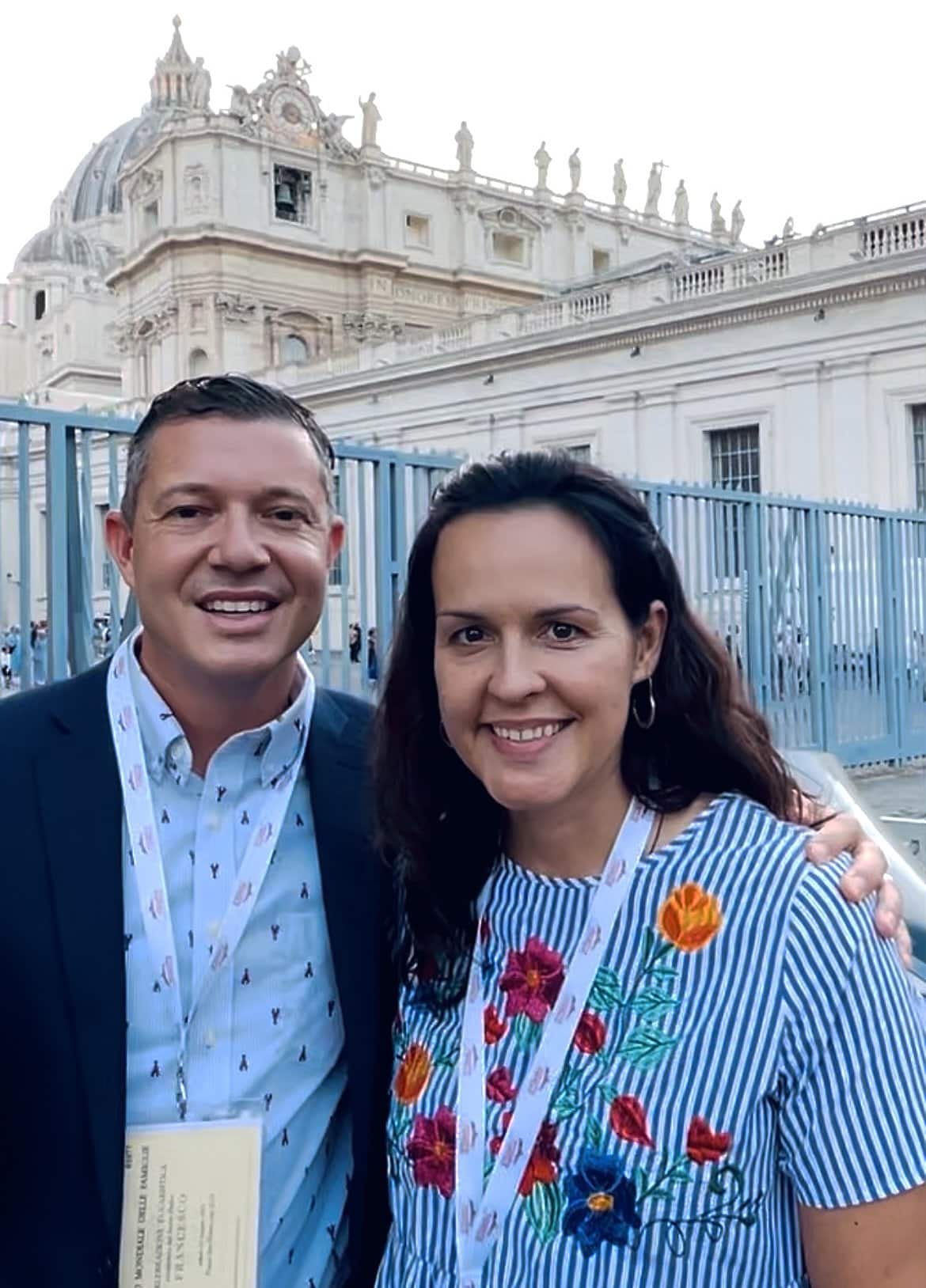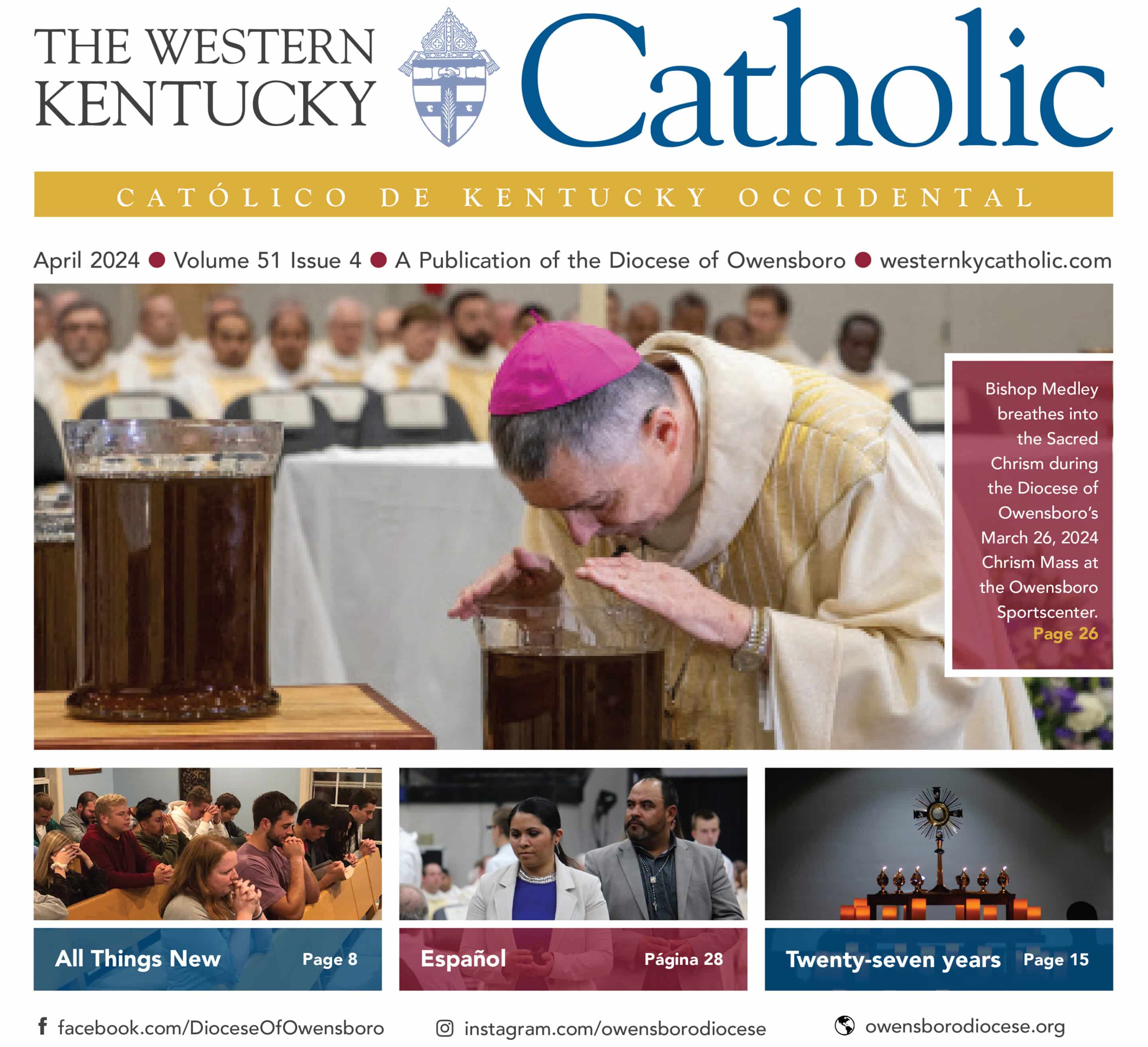
Ryan and Mary-Rose Verret of the Witness to Love Marriage Ministry are pictured at the Vatican in an undated photo. (OSV News photo/courtesy Verret family)
Meet the U.S. experts the Vatican is consulting for marriage formation advice
BY KIMBERLEY HEATHERINGTON, OSV NEWS
(OSV News) — Ryan Verret recalled the early morning text from a priest friend, which — being a congratulatory message — exploded onscreen in a burst of electronic confetti.
He had risen early Dec. 16 to get in some prayer time before his six children stirred. He replied, “Thank you — for what?” His friend then sent a picture of the Bollettino — the Vatican press office’s news summary.
The Bollettino had announced that Ryan Verret, along with his wife, Mary-Rose Verret, co-founders of the Witness to Love marriage formation and renewal ministry, were appointed “consultors” to the Vatican’s Dicastery for Laity, Family and Life.
“So I said, ‘Mary-Rose! Look at this!'” he recounted to OSV News.
His wife was skeptical, fearing a fake. “Of course I said, ‘Was this photoshopped?'” Mary Rose Verret added, laughing.
The authoritative confirmation, however, arrived later and by distinctly less modern means — a letter in Latin from Cardinal Pietro Parolin, the Vatican secretary of state, on behalf of Pope Francis.
It was formal recognition that the husband-and-wife team — who began their ministry a dozen years ago that today serves almost 90 North American dioceses — would officially be advisers to the Vatican. The Verrets are the only North American married couple appointed to such a role with the dicastery.
Attention from such high ecclesial places recognizes the success of the Witness to Love model, which is markedly different from other marriage preparation and reflects the catechumenal approach to marriage formation St. John Paul II envisioned and which Pope Francis made official.
The Witness to Love approach doesn’t just challenge couples — frequently fallen away from the church — to engage with church teaching and what being married means. It also involves close accompaniment by a practicing Catholic mentor couple — of their own choosing — who shares the couple’s journey to the altar and provides them a “lifeline” of support beyond the wedding day.
“When we were in Rome the most recent time, we were sharing with some of the top members of the dicastery the experience of marriage formation of the engaged in the United States,” Ryan Verret said. “They were really surprised to hear that in many dioceses throughout the U.S., marriage preparation is something that is outsourced — even to some type of third party — when it comes to the sacrament.”
“They’re often delegated to just watch some videos or answer some questions online,” Mary-Rose Verret added, referring to the to-be-wedded. “Zero accompaniment.”
The Verrets made clear they aren’t criticizing such programs per se — they do fill a need. The Verrets do question, however, their effectiveness as an option of first resort.
“If they (the couple) weren’t already going to church before the wedding, they won’t be going after,” Mary-Rose Verret said. “But with Witness to Love — going to church with the mentors; joining the community; growing in virtue; learning to pray; receiving the grace of the sacrament; going to confession; if they’re not Catholic, often becoming Catholic — they get to see what community is like.
“Evangelization only happens at the pace of a relationship and a friendship,” she explained. “And that’s what’s been missing. That’s the distinction — that it’s relational, evangelical, and it’s accompaniment.”
The Witness to Love model — and the different outcomes parish priests were observing first hand with couples compared to their previous pre-Cana experience — also apparently attracted the attention of the Vatican a few years ago.
“Our data shows this approach is lowering the divorce rate among those who are using it; it is attracting more people to the sacrament of marriage — we need them wanting to be married in the church — and they’re going to Mass,” Ryan Verret added.
He pointed out that St. John Paul really envisioned the marriage catechumenate approach now championed by Pope Francis in paragraph 66 of his 1981 papal encyclical on the family, “Familiaris Consortio.” He said the former pontiff observed essentially that “if they’re not going to church, to Mass, after the wedding day, then their marriage prep was a failure.”
Pope Francis also keenly realizes the challenges faced by modern couples — and responded by overseeing the Dicastery of Laity, Family and Life’s 2022 release of “Catechumenal Pathways for Married Life: Pastoral Guidelines for Local Churches,” a pastoral outline for preparing engaged couples for the sacrament of matrimony through a marriage catechumenate.
“Just as the catechumenate is part of the sacramental process for the baptism of adults, so too may the preparation for marriage form an integral part of the whole sacramental procedure of marriage,” Pope Francis wrote in his preface. He noted that giving couples a “superficial preparation” runs either the risk of celebrating a marriage which is either “null and void” or has “such a weak foundation that it ‘falls apart’ in a short space of time and cannot withstand even the first inevitable crises.”
The Center for Applied Research in the Apostolate, the Georgetown University-affiliated research center that conducts studies about the Catholic Church, notes that in 1965, marriages in the church in a previous year numbered 347,179. In 2022, the figure was 98,354.
“We are in a free-fall,” Mary-Rose Verret said with respect to sacramental marriage in the church, echoing Pope Francis. “And if this isn’t wake-up time, I don’t know what is.”
However, the Verrets also emphasize the marriage catechumenate is not simply to avoid modern marriage pitfalls — it’s meant to unlock the evangelizing potential of families St. John Paul saw within them. In 2023, the Verrets with OSV News national editor Peter Jesserer Smith co-wrote the book “The Road to Family Missionary Discipleship” as a practical roadmap for how churches can make the newly unveiled marriage catechumenate a starting point for families’ lifelong journey of following Jesus Christ and empower them to share Christ’s Gospel.
Julia Dezelski, associate director for marriage and family life at the U.S. Conference of Catholic Bishops’ Secretariat of Laity, Marriage, Family Life, and Youth, also was appointed to the Dicastery for Laity, Family and Life at the same time as the Verrets.
She, too, knows the importance of how building strong foundations for married life is key to strong families that pass on the faith.
“Without the family, the transmission of the faith simply does not take place,” stressed Dezelski. “And there’s been a poor transmission of the faith — which we’re seeing with the decline in numbers in church attendance; with the rise of the ‘nones’ and young adult populations; in the decline of marriage rates in general, but especially in the church.”
“Marriage as the foundation of the family is so important to emphasize,” Dezelski added. “So I’d like to continue to assist the Vatican — and work alongside the implementation plans for the marriage catechumenate.”
A new USCCB website — lovemeansmore.org — aims to provide resources to form an understanding of just what love is, apart from often superficial secular definitions.
It’s a complex and sensitive topic, Dezelski admits.
“I’d really like to encourage the dicastery and the Vatican to provide more clarity on these issues — to help create clarity around the anthropological issues of man and woman. And of course, that’s going to be a little difficult — especially since the recent document from the DDF,” Dezelski said, referring to the Vatican’s Dicastery for the Doctrine of Faith and its recent declaration “Fiducia Supplicans” (“Supplicating Trust”) on “the pastoral meaning of blessings.”
The eight-page document stated Catholic priests could bless people in same-sex unions and other irregular unions, such as divorced and remarried couples — provided that the extension of a blessing neither be confused with the church’s teaching on sacramental marriage nor occur within a liturgical celebration.
“It did create a bit of confusion, and has gotten some of us a little puzzled,” Dezelski reflected. “So these are important conversations to have.”
But she added that it’s part of the laity’s role to request clarity on these issues and remind the whole church “of the sure and solid Catholic teaching that we know to be true, long-lasting, and unchanging.”
Both the Verrets and Dezelski are guiding participants at the second Marriage Catechumenate Summit, to be held in Houston April 22-24.
“It’s meant to help our bishops and leaders — diocesan leaders, especially — better understand what the Vatican is proposing with this document,” said Dezelski, referring to “Catechumenal Pathways for Married Life.” She added the summit also helps participants “better understand how we might implement it at the local level, in the U.S. context.”
About 120 participants from both the U.S. and Canada took part at the 2023 summit.
“The last summit was cracking open the document,” Mary-Rose Verret said. “The emphasis this time is on strategic planning for what implementation of the marriage catechumenate might practically look like in a given diocese.”
One goal of the gathering is to prepare a summary to present to the U.S. bishops at a future general assembly meeting, which the bishops hold twice a year.
“All of this is just an effort of the entire church,” Dezelski said. “It’s up to all of us.”
Kimberley Heatherington writes for OSV News from Virginia.
For information about Witness to Love, visit https://witnesstolove.org. For information about the U.S. bishops’ website “Love means more,” visit https://lovemeansmore.org.

